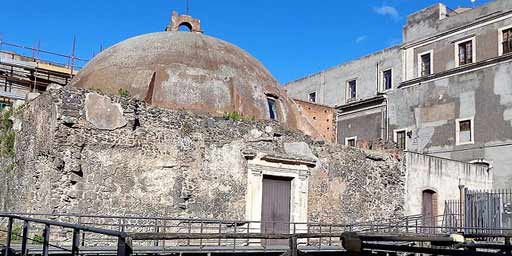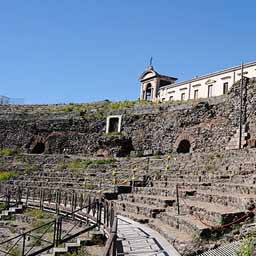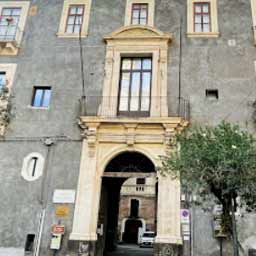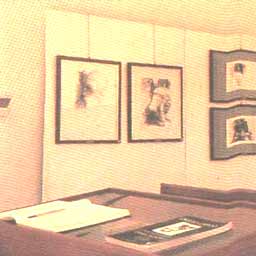Terme della Rotonda in Catania
The Archaeological Complex of the Terme della Rotonda is home to important archaeological and monumental testimonies that tell the story of Catania.
In the area pre-existences of the ancient Eneolithic and of the Greek age are testified.
Between the 1st and 2nd century A.D. a vast spa was built, which remained in use until the sixth century.
To date, nine rooms are known, arranged to the south and east of the large circular hall, called “Rotonda”, originally paved with mosaic or marble and with frescoed walls. To the north of the "Rotonda" room there is a large cistern, which, connected to a branch of the ancient aqueduct, fed the spa system. Built on a slope, the cistern on the southern side was supported by a high wall with exedras, connected to the Rotonda through a square courtyard, embellished on the sides by a system of arches. On the east and west sides of the court, the arches also continued inside the "Rotonda" room. The latter probably had its original entrance from the southern side of the court, through a large arch flanked by two minor arches.
The large hall has a square layout which, through an articulated radial system of arches and exedras, culminates in the center in a large circular space covered by a round dome.
In the penultimate decade of the sixth century, when the spa facility was abandoned, the hall was transformed into a church, with the construction of an apse, which occluded the central arch of the primitive entrance. The cistern was divided into two rooms at the service of the church, and two entrances were cut into the exedras of the southern wall.
The earthquake of 1169 seriously damaged the eastern side of the presbytery which was temporarily abandoned. By changing the orientation of the church, a new apse was built on the eastern side and a new entrance with a pointed arch, still existing, on the western side. In the late Renaissance, the primitive orientation was returned with the abandonment of the eastern apse. The repair of the old presbytery involved the occlusion of the system of arches from the Roman period; a new Mannerist-style entrance was opened on the southern side and the Rotunda took on a configuration similar to that maintained until the deconsecration of the church.
Starting from the sixteenth century, the area around the "Rotonda" was occupied by buildings that completely concealed the ancient structures, of which, as early as the mid-19th century, the memory had been lost.
In 1943 the Rotonda was damaged by bombing and closed for worship. After the war the sacred furnishings were removed, the frescoes chiseled and the floor, originally much higher, excavated to reveal the Roman thermal structures. The block south of the "Rotonda", destroyed by bombs, was subjected to archaeological excavations that have brought to light the Roman thermal building. On the north side, the square courtyard remained closed and inaccessible between the damaged buildings, of which, during the recent restorations, the street scenes that now enclose the archaeological area have been preserved. Other portions of the nineteenth-century buildings were, however, recovered and adapted to serve the monument and to welcome visitors.



